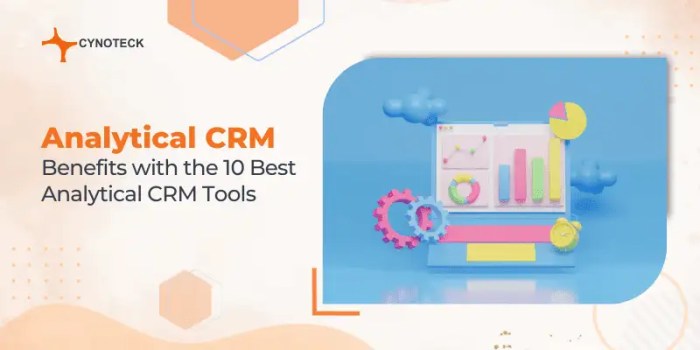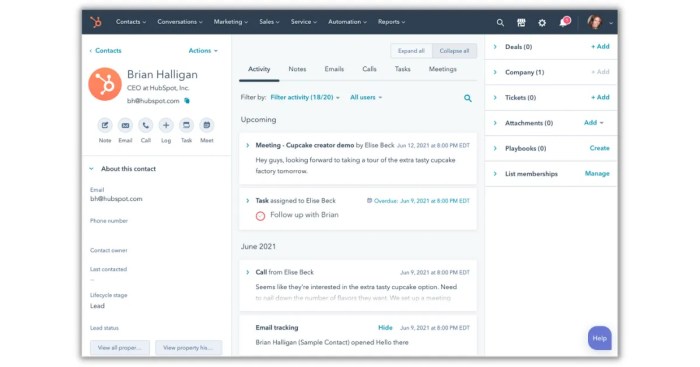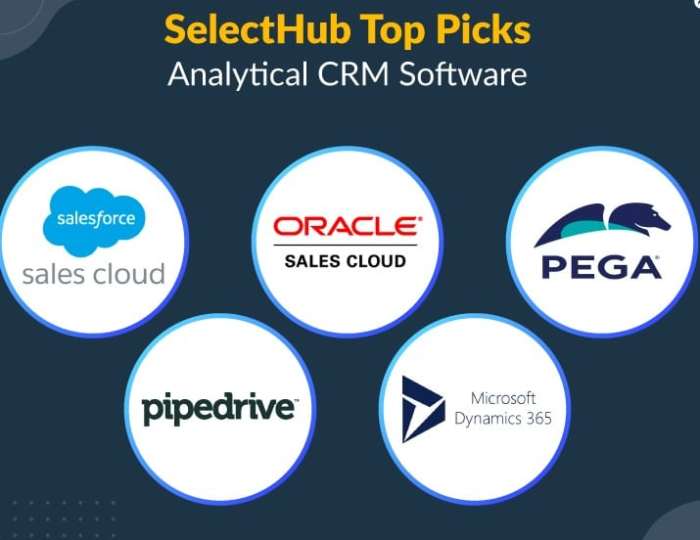Best CRM software with built-in analytics offers businesses a powerful combination of customer relationship management and data-driven insights. Understanding which CRM best suits your needs requires careful consideration of factors like ease of use, reporting capabilities, and integration with existing systems. This exploration will delve into the key features, benefits, and considerations involved in selecting the ideal CRM solution for your organization, ensuring you leverage data to enhance customer relationships and drive business growth.
The right CRM platform can significantly streamline operations, improve sales processes, and provide valuable insights into customer behavior. By integrating analytics directly into the CRM, businesses gain a real-time understanding of key performance indicators (KPIs), enabling data-driven decision-making and ultimately contributing to a more effective and efficient organization. This analysis will compare leading platforms, highlighting their strengths and weaknesses to assist in informed decision-making.
Defining “Best” CRM Software
Selecting the “best” CRM software requires a nuanced understanding of your business needs and a clear evaluation of various platforms. This involves considering several key criteria to ensure the chosen solution effectively supports your sales, marketing, and customer service processes. The definition of “best” is inherently subjective and depends heavily on individual business contexts.
Criteria for Evaluating CRM Software Effectiveness
Effective CRM software evaluation hinges on several critical factors. These include ease of use for all team members, robust functionality aligned with business goals, seamless integration with existing systems, reliable data security, and a scalable architecture to accommodate future growth. Cost-effectiveness, vendor support, and the availability of advanced analytics capabilities are also crucial considerations.
Essential Features of High-Performing CRM
A high-performing CRM system typically incorporates a comprehensive suite of features. These go beyond basic contact management and encompass functionalities like lead management, sales pipeline tracking, marketing automation integration, customer support ticketing, reporting and analytics dashboards, and customizable workflows.
- Contact Management
- Lead Management and Scoring
- Sales Pipeline Visualization
- Marketing Automation Integration
- Customer Service Ticketing
- Reporting and Analytics
- Workflow Automation
Examples of Business Needs and CRM Solutions
Different businesses have diverse needs. A small startup might prioritize ease of use and affordability, while a large enterprise may require sophisticated functionalities like advanced analytics and extensive customization options. For example, a retail business might need robust inventory management integration, whereas a SaaS company might prioritize features for managing subscriptions and recurring billing.
Comparison of Top-Tier CRMs
| Feature | Salesforce | HubSpot | Microsoft Dynamics 365 |
|---|---|---|---|
| Pricing | Various plans, starting from a per-user monthly fee | Freemium model with paid plans for advanced features | Various plans, with pricing based on user licenses and modules |
| Analytics | Comprehensive reporting and dashboards, customizable reports | Robust analytics with marketing and sales performance tracking | Strong analytics capabilities, integrated with Microsoft Power BI |
| Integration | Extensive app marketplace with integrations for various tools | Good integration with other HubSpot tools and third-party apps | Seamless integration with other Microsoft products and third-party apps |
Built-in Analytics Capabilities
Modern CRM systems are increasingly incorporating sophisticated built-in analytics capabilities. These tools provide valuable insights into sales performance, customer behavior, marketing campaign effectiveness, and overall business health. The ability to leverage these insights effectively is crucial for data-driven decision-making.
Types of Analytics in CRM Software
CRM analytics typically include several key functionalities, such as sales performance dashboards, marketing campaign analytics, customer segmentation analysis, predictive analytics for lead scoring and forecasting, and custom report generation. These tools provide a holistic view of customer interactions and business performance.
Analytic Functionalities Supporting Business Decisions
By analyzing sales data, businesses can identify top-performing products, pinpoint areas needing improvement, and optimize sales strategies. Marketing campaign analytics reveal which campaigns are most effective, allowing for resource allocation optimization. Customer segmentation helps personalize marketing efforts and improve customer satisfaction. Predictive analytics enables proactive sales forecasting and lead prioritization.
Data Visualization Capabilities of Leading CRM Platforms
Leading CRM platforms offer diverse data visualization options, including charts, graphs, tables, and interactive dashboards. These visualizations make it easier to understand complex data and identify key trends. For example, Salesforce offers customizable dashboards, while HubSpot provides pre-built templates and custom report creation tools. Microsoft Dynamics 365 integrates with Power BI for advanced visualization and reporting.
Key Performance Indicators (KPIs) Trackable with Built-in Analytics
- Customer Acquisition Cost (CAC)
- Customer Lifetime Value (CLTV)
- Conversion Rate
- Average Revenue Per User (ARPU)
- Sales Cycle Length
- Customer Churn Rate
- Lead Response Time
Top CRM Software Options
Several leading CRM platforms offer robust analytics capabilities. Salesforce, HubSpot, and Microsoft Dynamics 365 are frequently cited as top contenders, each offering a unique blend of features and functionalities tailored to different business needs and sizes.
Detailed Descriptions of Analytics Dashboards and Reporting Tools
Salesforce provides customizable dashboards and reports, allowing users to visualize key metrics and track performance across various dimensions. HubSpot offers a user-friendly interface with pre-built reports and dashboards, focusing on marketing and sales analytics. Microsoft Dynamics 365 leverages the power of Power BI for advanced data visualization and reporting, enabling complex analysis and custom report generation.
Pros and Cons of Three Leading CRMs
Each platform presents a unique set of advantages and disadvantages. The optimal choice depends heavily on specific business needs and priorities.
- Salesforce:
- Pros: Highly customizable, extensive integrations, robust analytics
- Cons: Can be complex to learn, expensive, requires technical expertise for advanced customization
- HubSpot:
- Pros: User-friendly interface, strong marketing automation capabilities, good analytics
- Cons: Fewer customization options compared to Salesforce, limited functionality in certain areas for larger enterprises
- Microsoft Dynamics 365:
- Pros: Seamless integration with other Microsoft products, strong analytics through Power BI, scalable for large enterprises
- Cons: Can be expensive, requires familiarity with Microsoft ecosystem
Data Integration with Other Business Systems
Effective CRM systems seamlessly integrate with other business tools, enhancing data flow and analysis. Salesforce boasts a vast app marketplace, while HubSpot integrates well with its own suite of marketing and sales tools. Microsoft Dynamics 365 integrates effortlessly with other Microsoft products, enhancing data consistency and analysis capabilities.
Data Visualization and Reporting
Effective data visualization is critical for extracting actionable insights from CRM analytics. Clear and concise presentations help stakeholders quickly grasp key trends and patterns, facilitating informed decision-making.
Chart Types and Applications in Presenting CRM Data
Various chart types are suitable for presenting different aspects of CRM data. Bar charts are useful for comparing performance across categories, while line charts illustrate trends over time. Pie charts show proportions, and scatter plots reveal correlations between variables. Heatmaps can display data density across multiple dimensions.
Sample Report Showcasing Key CRM Metrics

| Metric | January | February | March |
|---|---|---|---|
| Leads Generated | 150 | 180 | 210 |
| Conversion Rate | 10% | 12% | 15% |
| Average Deal Size | $5000 | $5500 | $6000 |
| Revenue | $75,000 | $118,800 | $199,500 |
Customization Options for Reports and Dashboards

Leading CRM platforms offer varying degrees of customization for reports and dashboards. Salesforce allows for extensive customization, enabling users to tailor reports to their specific needs. HubSpot offers pre-built templates and customization options, while Microsoft Dynamics 365 provides flexibility through integration with Power BI.
Integration and Customization
Seamless integration with other business tools and the ability to customize reports and dashboards are essential for maximizing the value of CRM analytics. This allows businesses to consolidate data from various sources, creating a holistic view of their operations and customer interactions.
CRM Software Integration with Other Business Tools
CRM systems often integrate with marketing automation platforms (e.g., Marketo, Pardot), sales intelligence tools (e.g., LinkedIn Sales Navigator), and customer support platforms (e.g., Zendesk, Intercom). These integrations streamline workflows, enhance data consistency, and provide a unified view of customer interactions.
Options for Customizing Reports and Dashboards
Customization options vary across CRM platforms. Some offer drag-and-drop interfaces for creating custom dashboards, while others require coding skills for more advanced customization. Many platforms provide pre-built templates that can be adapted to meet specific needs.
Examples of How Custom Integrations Enhance Analytical Capabilities
Integrating a CRM with a marketing automation platform allows for tracking the effectiveness of marketing campaigns and attributing revenue to specific channels. Integrating with a sales intelligence tool provides richer customer profiles, enhancing lead scoring and sales forecasting accuracy. Integration with a customer support platform allows for analyzing customer service interactions and identifying areas for improvement.
Data Security and Privacy within CRM Analytics
Data security and privacy are paramount when implementing CRM analytics. Businesses must choose platforms with robust security features, comply with relevant data privacy regulations (e.g., GDPR, CCPA), and implement appropriate data governance policies to protect sensitive customer information.
Cost and Scalability: Best CRM Software With Built-in Analytics
Choosing a CRM system involves careful consideration of cost and scalability. The pricing model, features offered at different price points, and the platform’s ability to accommodate future growth are all crucial factors to evaluate.
Pricing Models of CRM Platforms with Built-in Analytics

CRM platforms typically offer various pricing models, including per-user monthly subscriptions, tiered plans with increasing features, and custom enterprise solutions. The cost can vary significantly depending on the features required, the number of users, and the level of customization needed.
Scalability of CRM Platforms in Relation to Business Growth and Data Volume
Scalability is crucial for accommodating business growth and increasing data volumes. Cloud-based CRMs generally offer better scalability compared to on-premise solutions. It’s essential to choose a platform that can handle your current data volume and anticipated future growth without significant performance degradation.
Comparison of Pricing Tiers and Features Across Three Selected CRM Systems
| Feature/Plan | Salesforce (Example Plan) | HubSpot (Example Plan) | Microsoft Dynamics 365 (Example Plan) |
|---|---|---|---|
| Price | $75/user/month | $500/month | $100/user/month |
| Users | Up to 10 | Up to 5 | Up to 20 |
| Storage | 10 GB | 100 GB | 50 GB |
| Analytics | Standard reporting and dashboards | Basic reporting and dashboards | Advanced reporting and dashboards with Power BI integration |
Factors to Consider When Choosing a CRM Based on Budget and Future Needs, Best CRM software with built-in analytics
When selecting a CRM, consider your current budget, anticipated growth trajectory, and long-term strategic goals. Factor in implementation costs, ongoing maintenance expenses, and the potential need for future upgrades or customizations. Choose a platform that offers the right balance of features, scalability, and cost-effectiveness for your business.
Closure
Choosing the best CRM software with built-in analytics involves a careful assessment of your specific business needs and priorities. By considering factors like data visualization capabilities, integration options, scalability, and cost, businesses can select a platform that empowers them to effectively manage customer relationships, gain valuable insights, and ultimately achieve sustainable growth. The platforms discussed here represent some of the leading options, but thorough research and potentially trial periods are recommended before making a final decision.
FAQ Resource
What is the difference between CRM and CRM with built-in analytics?
A standard CRM manages customer interactions. A CRM with built-in analytics adds data analysis tools, providing insights into customer behavior and business performance directly within the CRM platform, eliminating the need for separate analytical tools.
How much does CRM software with built-in analytics typically cost?
Pricing varies greatly depending on the vendor, features, and the number of users. Expect a range from affordable monthly subscriptions for smaller businesses to substantial enterprise-level contracts for larger organizations.
Can I integrate my CRM with other software I already use?
Most modern CRMs offer robust integration capabilities with other business tools like marketing automation platforms, email marketing services, and accounting software. However, the specific integrations available vary depending on the chosen CRM.
What types of reports can I generate with built-in CRM analytics?
The types of reports vary by platform but commonly include sales performance reports, customer segmentation reports, marketing campaign effectiveness reports, and customer service performance reports. Many platforms allow for custom report creation.
